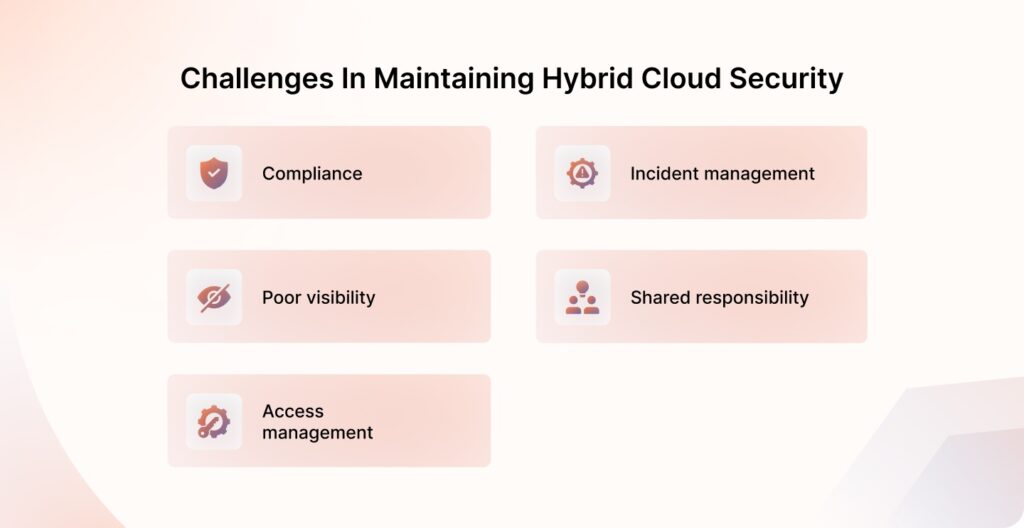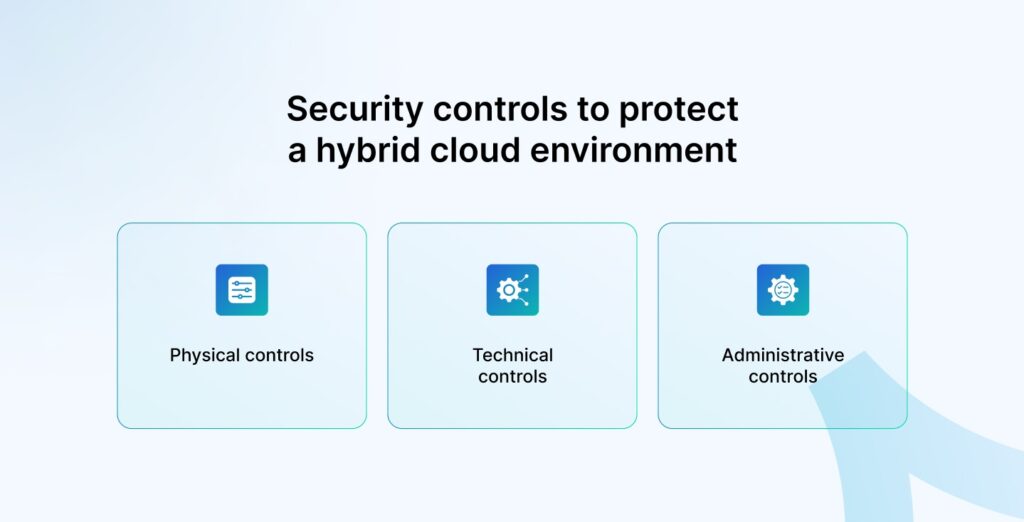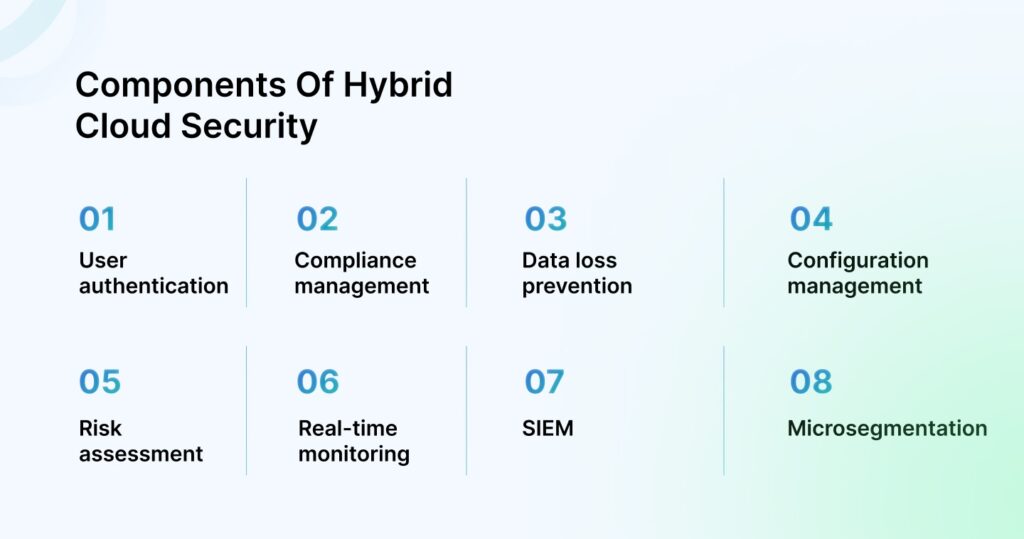Hybrid Cloud Security: Best Practices and How to Overcome Challenges
Anwita
Jan 02, 2025
Imagine a rail control center where all trains are operated from a single center. This module is fairly simple. Now imagine the same control center burdened with managing airplanes and ships with interdependent schedules, further complicating operations.
A hybrid cloud setup looks somewhat like an operation center described above. Without a standardized flow of data from a single pane that provides 360 visibility that harmonizes the different components, managing the sub-components can be a pain. Hybrid cloud security systems aim to bridge the gaps caused by such siloed systems by bringing them together.
In this article, we explore what a hybrid cloud security entails, the challenges, and best practices to ensure its security.
TLDR
TLDR
| Challenges associated with a hybrid cloud are meeting compliance requirements, gaps due to poor visibility, managing access for various roles across different clouds, and managing incidents. The main components of a hybrid cloud architecture are DLP systems, SIEM tools, microsegmentation, and configuration management. To protect your hybrid cloud system, conduct internal audits, monitor your environment in real-time, use a security framework, and encrypt sensitive data. |
What is hybrid cloud security?
Hybrid cloud security refers to protecting sensitive data, systems, and other facilities of an IT architecture that involves at least one private and one public cloud. It combines some level of workload governance, technologies, and practices that enable security teams to manage permissions, system changes, compliance requirements, policies, and other complex components from a unified architecture.
“Security is always going to cost you more if you delay things and try to do it later. The cost is not only from the money perspective but also from time and resource perspective”
Ayman Elsawah (vCISO) with Sprinto
Challenges in maintaining hybrid cloud security
Since a hybrid cloud model has a larger attack surface, running it has some major drawbacks. Some hybrid cloud security challenges are managing the compliance posture, implementing security policies for each storage, setting up role-based access control, and mitigating a wide range of cyber threats.
Compliance
A hybrid cloud environment facilitates greater control due to the compartmentalized systems and processes. However, a distributed environment introduces new challenges and complexities, especially for highly regulated sectors like financial services, healthcare, and government. Meeting additional regulatory requirements like HIPAA, GDPR, and NIST adds more checklists and complexities to the already complicated hybrid infrastructure.

Automate ISO 27001, HIPAA, GDPR compliance effortlessly. Get a demo now.
Poor visibility
Managing all the moving parts of a hybrid cloud setup requires real time visibility, especially to meet the requirements of mandatory regulatory frameworks. Without a dedicated and centralized management dashboard, it is easy to overlook gaps that may escalate into a security incident.
Access management
Due to its decentralized nature, access control involves more intricacies compared to an on premise only ecosystem. This is because multiple cloud systems comprising various roles, each with a unique set of access requirements. Your team has to work out the permutation combination for every use case to circumvent.
Incident management
One of the drawbacks of a distributed environment is investigating an incident. When you deploy multiple systems, tracking the cyber kill chain can be a challenge. Troubleshooting and isolating the incident takes more time given that the process differs for each system. Even after you have identified it, coordinating the response across multiple environments is tricky.
Shared responsibility
If the responsibility of managing the compliance, security, risks, and processes of the cloud architecture falls on a single team or individual, expect fewer complexities than a scenario with shared responsibility. In such cases of multiple clouds with a head assigned for each, it is important to correctly segment the accountability, expectations, and requirements for stakeholders, internal departments, and customers alike. Everyone involved should have a clear understanding of their tasks.
Security controls to protect a hybrid cloud environment
Controls in a hybrid setup can be of three types – physical, technical, and administrative. Let’s understand what each entails.

Physical controls
Given that hybrid cloud infrastructures are deployed across multiple locations, physical security is an important responsibility. Unlike cloud only hosted systems, you can’t protect it using a network perimeter around it and use passwords/ encryption as the door lock.
Examples of physical security controls are motion detectors, surveillance systems such as CCTV cameras, biometric scanning systems, and even backup generators to ensure the cloud ecosystem operates during power outages.
Note: If you share management of cloud facilities with a third party provider, having a Service Level Agreement (SLA) is recommended.
Technical controls
Technical controls are the core of a cloud environment. To build a highly resilient hybrid cloud security architecture, these controls are a must:
- Data encryption: The practice of transforming readable information into unreadable code protects it from unauthorized access. This way, you reduce the risk of data exposure in the event of a compromise and possible damages due or unintentional transmission. You can use encryption for both data at rest and data in motion.
- User authentication: A hybrid cloud setup creates an ecosystem of interdependency; one application can depend on one or more providers to run. So if a user requests services from multiple cloud environments, they have to be authenticated.
- SOAR: Security orchestration, automation and response systems helps to coordinate, streamline, and automate tasks between people and tools. Since processes can get a little complicated in a hybrid ecosystem, centralizing the workload solves for the intricacies.
- Unified endpoint management: UEM solutions provide a single interface to secure all endpoint devices like iot, smartphones, tablets, laptops, and more. This umbrella approach helps to manage all systems across multiple clouds.
Administrative controls
Cloud components are operated by the people, policy, and technology triad. The people component is a critical factor as human responsibility can make or break the posture.
Administrative controls help businesses prepare for disaster recovery. For example, in the event of an outage or failure of any point in the cloud, a business continuity plan should kick in to ensure that all parts are moving and functioning as intended. This includes well thought out protocols, policies, responsibilities, and backup systems.
What are the key components of hybrid cloud security?
A hybrid architecture is composed of critical components like multi-factor authentication systems, private networks, security standards, cloud data protection tools, network segmentation, and hybrid cloud security solutions. Let’s understand these elements of a hybrid security landscape:

- User authentication: Allows only the right people to view, access, and manage sensitive tools and applications using identity and access management tools.
- Compliance management: Helps IT and security teams adhere to data security and privacy regulations and implement its guidelines.
- Data loss prevention: Monitors data entering and leaving the network perimeters to prevent unauthorized transfer, unintentional damage, and any misuse.
- Configuration management: Tracking, updating, and evaluating cloud hosted systems like antivirus solutions for reducing vulnerabilities and running the latest version.
- Risk assessment: Evaluating the risk posture helps to identify security vulnerabilities that can trigger an incident and assess if the controls are functioning as intended.
- Real-time monitoring: Critical especially if your goal is to adhere to a framework to know if there are any gaps against the expected set of policies, control implementations, and other checklist items.
- SIEM: Security information and event management tools to monitor and analyze security events and the data environment in real time.
- Microsegmentation: A security practice of zoning networks at the application level to boost security, improve visibility, and enhance control granularity.
How to implement a hybrid cloud security strategy?
To implement a hybrid cloud security, you should familiarize yourself with these key steps to ensure the protection of data, applications, and infrastructure across both on-premises and cloud environments:
- Assess current infrastructure: Evaluate your existing on-premises and cloud environments to identify security gaps, vulnerabilities, and compliance requirements. This helps to understand the current state and planning for integration.
- Define security policies: Establish consistent security policies that apply across both environments. This includes access controls, data protection measures, encryption standards, and compliance with regulatory requirements.
- Implement Identity and Access Management: Deploy a unified IAM solution to manage user access across on-premises and cloud environments. Implement multi-factor authentication (MFA), role-based access controls (RBAC), and single sign-on (SSO).
- Deploy security monitoring tools: Implement monitoring and logging tools that provide visibility into both on-premises and cloud environments. These tools should be able to detect and alert on security events, suspicious activities, and potential breaches.
- Establish network security controls: Configure firewalls, intrusion detection/prevention systems (IDS/IPS), and virtual private networks (VPNs) to secure data flow between on-premises and cloud environments. Segment the network to limit access and reduce the attack surface.
- Implement Data Loss Prevention: Deploy DLP solutions to prevent unauthorized access, sharing, or loss of sensitive data. This ensures that data is protected regardless of its location within the hybrid environment.
- Regularly patch and update systems: Ensure that all systems, applications, and security tools are regularly patched and updated to protect against vulnerabilities. Automate this process where possible to maintain consistent security.
Best practices of hybrid cloud security
Hybrid cloud security is complex and multilayered. To address the risks and vulnerabilities, you need to adopt these best practices:
- Conduct frequent audits: Evaluating the security posture internally or via third-party cloud service providers helps to identify the right controls and prioritize risks to prevent incidents, comply with regulatory requirements, and bolster resilience.
Sprinto removes manual effort and organizes everything you need to ace security audits. Implement auditor-grade security programs to prove compliance with frameworks like SOC 2, ISO 27001, and PCI. Sprinto removes manual effort and organizes everything you need to ace security audits. Implement auditor-grade security programs to prove compliance with frameworks like SOC 2, ISO 27001, and PCI. See Sprinto in action.
- Use a unified security solution: Instead of deploying a solution for each component, opt for a single solution that offers end-to-end capabilities to detect, monitor, identify, mitigate, and investigate potential threats and vulnerabilities. This helps your team address issues from a single dashboard and significantly cuts down on security costs.
- Encrypt sensitive data: Information, no matter where deployed; on cloud or on premise, should be encrypted. As the number of ransomware attacks continues to rise, encrypting sensitive data ensures that even if malicious actors have access to your information, they can’t decipher it.
- Use a security framework: Setting up a hybrid cloud security infrastructure from scratch has a number of intricacies, and security administrators often miss important bits. Security frameworks like ISO 27001 and NIST CSF offer detailed guidelines, best practices, recommendations, and processes so that businesses of all sizes can set up and maintain a strong posture.
- Continuously monitor your environment: Audits are conducted once every few months; while necessary, they are not enough given the frequency. This is why it is critical to set up an automated system that continuously monitors your environment to identify and patch vulnerabilities in real-time.
- Map your data and controls: Some data are more critical than others. Protecting every piece of information in your infrastructure is a time-consuming, resource-heavy, and costly affair. Identify critical assets deployed across the cloud systems, analyze the possible hybrid cloud risks, and identify the measures to protect them.
How to overcome the challenges of hybrid cloud system
By now you should know that running a hybrid cloud environment is no cakewalk. If you miss a small gap, it can escalate into an incident that halts all operations in a matter of minutes.
Security compliance automation tools like Sprinto help security professionals continuously monitor the environment for anomalous behavior, alert the right person of failing controls, and run real-time vulnerability scanning.
Its vulnerability and risk management modules empower cloud companies to continuously monitor and manage threats across networks, code, and deployments. The tool integrates easily with existing cloud setups to track the overall health of security controls, and identify and address issues as they arise.
Sprinto comes with a library of risks with industry benchmarks for impact. This helps you prioritize risks unique to your business and assess them with empirical rigor.
The platform ensures compliance with security policies and ensures timely resolution throughout the life cycle of risks. Talk to our cloud security experts to know how we can help your business.
FAQs
What are the benefits of hybrid cloud security?
Hybrid cloud security combines the strengths of public and private clouds, offering enhanced data protection and flexibility. It allows businesses to optimize costs by using public cloud resources while keeping sensitive data secure in private environments. This approach also ensures compliance with regulatory requirements and enables seamless scalability.
What are the best hybrid cloud security tools?
Some of the best hybrid cloud security solutions are Sprinto, Microsoft Azure Security Center, Google Cloud Security Command Center, Palo Alto Networks Prisma Cloud, IBM Cloud Security and Compliance Center, and Fortinet FortiGate.


Use Sprinto to centralize security compliance management – so nothing
gets in the way of your moving up and winning big.





















